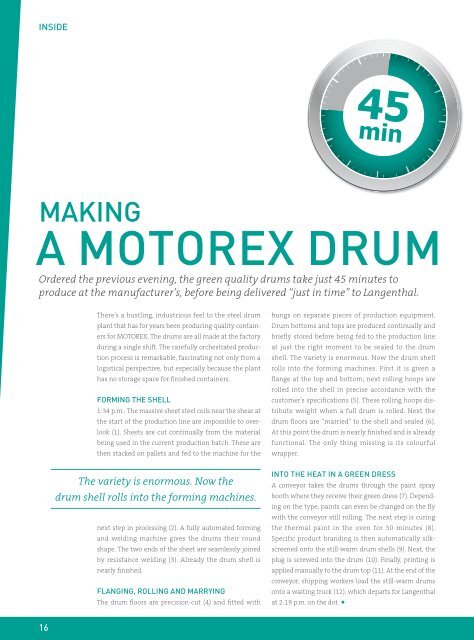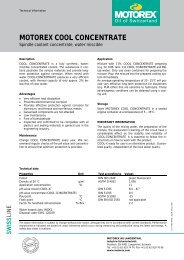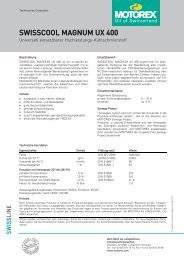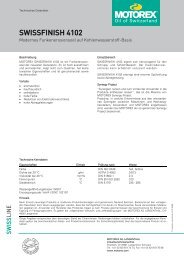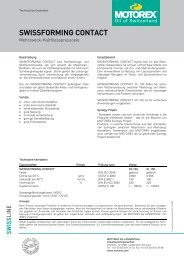SUCCESS UNITES - Motorex
SUCCESS UNITES - Motorex
SUCCESS UNITES - Motorex
Create successful ePaper yourself
Turn your PDF publications into a flip-book with our unique Google optimized e-Paper software.
INSIDE<br />
MAKING<br />
A MOTOREX DRUM<br />
Ordered the previous evening, the green quality drums take just 45 minutes to<br />
produce at the manufacturer’s, before being delivered “just in time” to Langenthal.<br />
16<br />
There’s a bustling, industrious feel to the steel drum<br />
plant that has for years been producing quality containers<br />
for MOTOREX. The drums are all made at the factory<br />
during a single shift. The carefully orchestrated production<br />
process is remarkable, fascinating not only from a<br />
logistical perspective, but especially because the plant<br />
has no storage space for fi nished containers.<br />
FORMING THE SHELL<br />
1:34 p.m.: The massive sheet steel coils near the shear at<br />
the start of the production line are impossible to overlook<br />
(1). Sheets are cut continually from the material<br />
being used in the current production batch. These are<br />
then stacked on pallets and fed to the machine for the<br />
The variety is enormous. Now the<br />
drum shell rolls into the forming machines.<br />
next step in processing (2). A fully automated forming<br />
and welding machine gives the drums their round<br />
shape. The two ends of the sheet are seamlessly joined<br />
by resistance welding (3). Already the drum shell is<br />
nearly fi nished.<br />
FLANGING, ROLLING AND MARRYING<br />
The drum fl oors are precision-cut (4) and fi tted with<br />
bungs on separate pieces of production equipment.<br />
Drum bottoms and tops are produced continually and<br />
briefl y stored before being fed to the production line<br />
at just the right moment to be sealed to the drum<br />
shell. The variety is enormous. Now the drum shell<br />
rolls into the forming machines. First it is given a<br />
fl ange at the top and bottom; next rolling hoops are<br />
rolled into the shell in precise accordance with the<br />
customer’s specifications (5). These rolling hoops distribute<br />
weight when a full drum is rolled. Next the<br />
drum fl oors are “married” to the shell and sealed (6).<br />
At this point the drum is nearly fi nished and is already<br />
functional. The only thing missing is its colourful<br />
wrapper.<br />
INTO THE HEAT IN A GREEN DRESS<br />
A conveyor takes the drums through the paint spray<br />
booth where they receive their green dress (7). Depending<br />
on the type, paints can even be changed on the fl y<br />
with the conveyor still rolling. The next step is curing<br />
the thermal paint in the oven for 30 minutes (8).<br />
Specific product branding is then automatically silkscreened<br />
onto the still-warm drum shells (9). Next, the<br />
plug is screwed into the drum (10). Finally, printing is<br />
applied manually to the drum top (11). At the end of the<br />
conveyor, shipping workers load the still-warm drums<br />
onto a waiting truck (12), which departs for Langenthal<br />
at 2:19 p.m. on the dot. •


